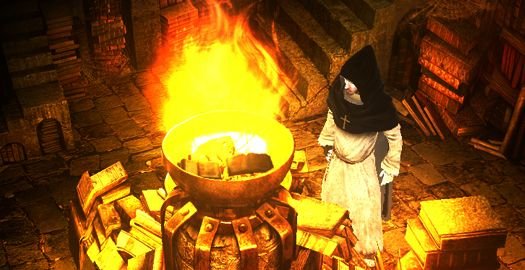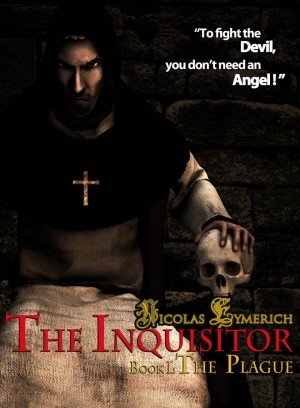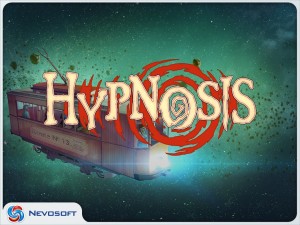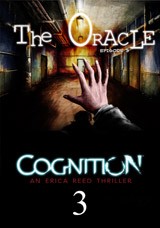Review for The Inquisitor: Book 1 - The Plague

It is AD 1364, a dark time for the small village of Calcares in southern France that finds itself in the grips of a lethal plague that has decimated its population. The prior of the abbey at nearby Carcassonne suspects the disease to be of demonic origin, so he summons notorious inquisitor Nicholas Eymerich to investigate the case. Eymerich's reputation as a resourceful and committed – and suitably ruthless – defender of the Catholic Church makes him the ideal candidate for the job, and he is directed to visit the village to determine the nature of the illness as well as the fate of a missing monk, Father Corona. But even before he can saddle his horse, Eymerich stumbles onto evidence of heresy at the abbey itself, which delays his trip and sets up the first episode in the planned four-part series, The Inquisitor. Subtitled The Plague, this opening installment is an erudite, nuanced and unapologetically cruel start to a grim, socio-religious mystery, and despite many minor gameplay nitpicks that tarnish its appeal, it is a sincere, ambitiously crafted game that achieves its core objective of creating interest in the ongoing series.
The game is adapted from a set of sci-fi / fantasy novels by contemporary Italian author Valerio Evangelisti, who in turn has drawn inspiration from the real Nicholas Eymerich, a Dominican priest and Inquisitor General of the Spanish Inquisition, entrusted with pursuing – and where possible, quashing – paranormal and Satanic incidences in medieval Europe. This three-hour debut details the history-laden plot via conversations and books, and features a moderately challenging mix of inventory quests and standalone puzzles. Clever use of light and shadows, detailed facial expressions, well-written and nicely voiced dialogues, and a steady pace of revelations create a palpable sense of something wrong beneath the all-pervading veneer of sanctimony, and will keep you engaged till the cliffhanger-ish end. This is despite some clunky game mechanics like maneuvering Eymerich and objects at times, as well as pixel-hunting, randomly activated locations and hotspots, some poorly clued puzzles, and a few disruptive glitches. Even with these foibles, however, the interesting story and superb characterisation of Eymerich are sufficient reasons to give this Inquisitor a fair chance.
The plot blends religious beliefs and supernatural events to create horrors both real, like the putrefied, distorted corpses of those killed by the pestilence, and surreal, where visions of pagan deities – demon women with flames for hair and such – haunt the followers of the Church. Underneath this overarching crisis lies a more insidious problem: moral and ideological corruption within the Church itself. Centuries of crusades against various groups of people have resulted in a multitude of covert opposition, and this in turn has led to increasing paranoia among Church members over their weakening grip on those they controlled through force and fear. The abbey at Carcassonne is no longer a haven of pure faith, and appears, at the moment, to be the tip of the proverbial iceberg of internal conspiracies.
Meanwhile, Eymerich is the polar opposite of a conventional hero. Tall, bony and middle-aged, he is arrogant, impatient and indiscriminately rude towards anyone who offends his finely-honed sensibilities, be it other monks, guards, servants, ladies, and even the wheezing, manipulative prior, Abbot Vinet. Fanatical in his devotion to the Church, he considers the calculated, gruesome murders of those he condemns as heretics his duty, to the extent of even enjoying the process. He frequently refuses tasks with snide putdowns like, "I hate touching things. Particularly for no particular reason," and is downright vicious when offered a well-meaning glass of lemonade. However, at no point does he come across as boorish, as his outrageous superiority complex is justified by his obviously high intelligence, bolstered by the vast amount of knowledge he possesses from his travels and studies; his keen sense of the true motives of people; his unwavering personal integrity (within the limitations of his faith); and interestingly, his scathing wit. The game walks a constant tightrope with his characterisation, balancing each shocking negative trait with an impressive positive one, and thereby gives us one of the most offensive, intriguing, and perversely likeable protagonists of all time.
There are few other characters in this episode. The elderly Vinet is a crafty, politically-savvy man who subtly obstructs Eymerich's quest despite being the one who initiated it. A shady librarian stutters his way through a web of half-truths that threaten the very core of the abbey, while a few errand boys gossip about the recent goings-on at the village. Vinet's crass mercenary guard excels at grating on Eymerich's sensitive nerves with his shenanigans, while a rustic innkeeper incurs his wrath by merely being polite. There aren't too many locations either: set almost entirely at the abbey except for a brief segment at Calcares at the end, Eymerich shuttles via long corridors between Vinet's office, a cluttered kitchen, a tiny library, a dreary courtyard, his miniscule room and a couple of secret chambers.
The gameplay unfortunately lacks the finesse of the storytelling. The process itself is uncomplicated, as left-clicking an object brings up the possible interactive options, such as look at, get a close-up, or take, open, or use it, while right-click is left unused. Collected items, about half a dozen at a time on average, are added to an inventory at the top of the screen, to be used with each other or onscreen hotspots. But the playing experience is hampered by a litany of nitpicks: objects are described in plain white text at the base of the screen, which is frequently lost amidst the background art; some hotspots are extremely small or placed right next to others, and in the absence of a hotspot revealer, require sweeping each screen with the mouse to detect; the inventory must be clicked to open and items then clicked to bring up usage options, requiring a third click to use them; and areas, objects and even alternate viewing perspectives of existing places become accesible without notice, making you repeatedly revisit previous scenes scouting for such changes. One puzzle that needs a part to be dragged onto another may take a few tries to manage, while a sometimes-there-sometimes-not hotspot had me stumped at a crucial juncture towards the end. The game also froze up frequently for me, proving the ten save slots to be essential.
Eymerich jots his objectives in an omnipresent journal and recites them aloud ad nauseam when kept idle. He also sketches out, in amusing chicken scratches, key events in the diary, skipping pages if you miss something – which is possible, because the game is not entirely linear, and quite a few activities appear to be optional. His reference notes chronicle the bizarre abominations he has encountered in the past, some of which refer to the plots of Evangelisti's novels. While the stories are not legible, sometimes Eymerich deigns to reminisce a bit about a particular case. Continuing the little annoyances, unfortunately, the journal always opens on the first page instead of the latest one. At one point, a map of the abbey is added to your repertoire, which usually – but not always – marks out Eymerich's location, and is supremely helpful in allowing teleportation between most available areas. The map also shows your current score out of a hundred, which is augmented by collecting items, solving puzzles, and discovering Easter Eggs like developer logos. The latter warrants serious pixel-hunting, and it's obviously easy to miss lots of stuff because I ended with a paltry score of 73.
Puzzles cover inventory-based quests and figuring out cryptic patterns and locks. Items are sparsely distributed and easy to spot, and most are practical. While some may be collected right away, others must be fetched only when the need arises. Besides a jigsaw, standalone puzzles are more or less limited to memory-based pattern clicking. Though well-inserted into the plot and extremely detailed visually, these are usually solved by trial and error due to insufficient clues. While it's true that Eymerich didn't have an instruction manual to unveil the abbey's secrets either, in a game such experimentation borders on tedium. Poor design also mars some of the puzzles: an area with multiple minigames to be solved in a certain order is confusing due to its candlelit top-down perspective, and Eymerich can get physically stuck in a corner, requiring you to reload the game. Also deserving mention is a sadistic quest to find an unmarked object amidst a massive collection of similar unmarked objects – in flickering firelight. Another nightmare is a lengthy psychedelic dream quest that not only takes the wind out of your sails with its slow, boring pace, but also assaults you with blinding flashes of light, an ill-suited electronica track, and a distorted voiceover.
If you need a hint, a crucifix is on hand to perform the next logical action for you, though it costs one point of your score per use and the crucifix needs half a minute to recharge. In theory, this keeps you from getting hopelessly stuck – in theory being the operative words, because the one time I was truly stuck, this mechanism did nothing except take me back to the scene where I was stuck.
The Inquisitor's 3D art is well executed. The game is compatible with many screen resolutions, and offers several qualities of graphics, from fast to fantastic. A solemn ambience is created by the interplay of shadow and light, from sunlight streaming in through windows to torches weakly lighting dank hallways, and viewing angles change often during conversations, with zoom-ins and pans reflecting a movie-like style. While the locations are illustrated with realism and often intensely coloured, particularly using vivid red and the warmth of firelight, the abbey is a dreary place, and after a while it starts to drag you down. Character close-ups are impressively textured; the shifty expressions of Vinet and the myriad reactions of Eymerich, especially the glint in his sharp green eyes when he's up to no good, are very realistic. Also smart is the way people instinctively turn to look at Eymerich when he nears them, even if he's just passing by.
Notable animations include an attack on Eymerich, a secondary character's slow and painful death, the mechanisms of the standalone puzzles, and a scene with raindrops splattering on a corpse with slowly pulsing pustules. Many of Eymerich's actions are shown in detail, like when he drags a dead body around or places a torch in its holder, but item combinations are done with his back to the screen and lip sync only sort of matches the spoken dialogues. On the downside, long shots of characters show jagged edges, and in high-traffic areas like the courtyard, they tend to bump into each other and get stuck. Some animations, like movements of hands while speaking, are oddly languorous, as if the people are underwater. The cutscenes are dramatic enough, but blurry at high resolution.
One of the strongest points of the game is its crisp, no-nonsense script, which explains the lengthy history of the Crusades and the plague crisis with impressive brevity. Conversations are kept to the point but cleverly convey emotional undercurrents. Barring a few typos, the written text is adeptly translated from its native Italian, with no awkward sentences, and the dialogues flow smoothly. A strong English voice cast, led by the exceptional performance of Daniel Richards as the brusque, overbearing Eymerich, lends further credence to the screenplay. The raspy, wavering voice and calculated comments of the aged Vinet, the obnoxious bragging of his uncouth guard, and the stammered deflections of the cagey librarian are all delivered expertly. The full game is available in Latin as well, as you can choose to have Latin voices and/or subtitles, and it's quite the novelty to listen to that.
In an elegant move, the game chooses not to have a continuous background soundtrack. The quietness suits the somber abbey, and allows sound effects like the ordinary noises of the monks going about their business and the incessant rain at Calcares to strengthen the sense of immersion. On occasion, however, like during a particular fracas with a monk, the sound loses sync with the onscreen action. The theme music, which plays during watershed moments, uses heavy guitar riffs and beat-based drums, and works surprising well with the medieval backdrop.
In terms of plotline, The Inquisitor: Book 1 - The Plague is a potent first episode for a series based on a complex, history-driven story and a controversial, even offensive, protagonist. It does well to pique your interest in the case of the demonic plague of Calcares, and engages you strongly enough to develop definitive opinions about the religious aspects and the people involved. It makes the effort to devise puzzles in line with the setting of a medieval European abbey, and invests in quality screenplay, localisation and voice acting. Too much of this good work, however, is undone by the inconsistent gameplay, inefficient interactivity mechanics, insufficient instructions, and avoidable glitches that rudely yank you out of an otherwise engrossing game. Even so, there is enough here to keep you intrigued for the next episode, and one hopes that the rough edges of this opening installment are smoothed out in future to raise the playing experience up to the superior standard that the Inquisitor demands.



_capsule_fog__medium.png)






















__small.jpg)



